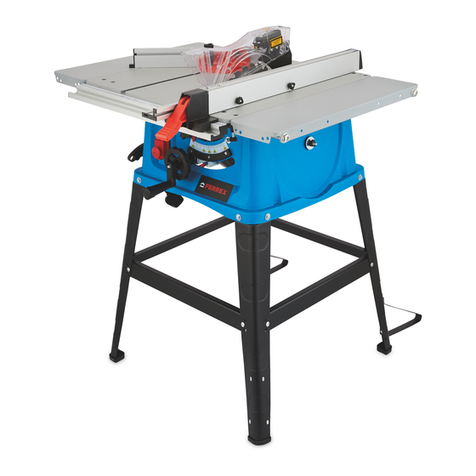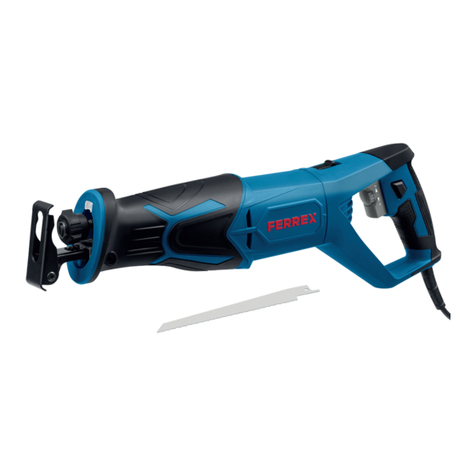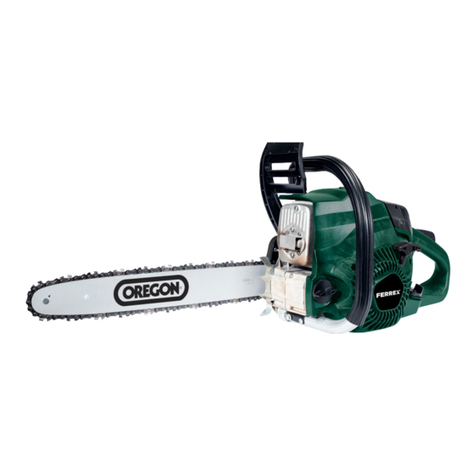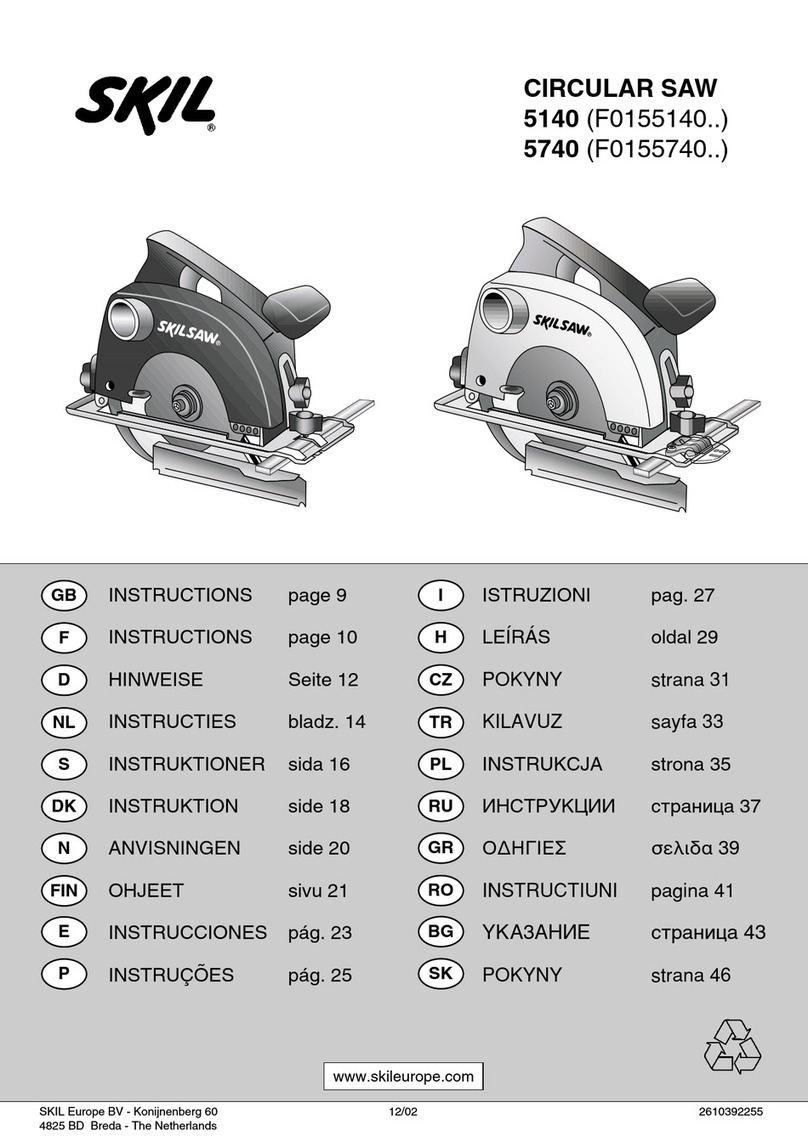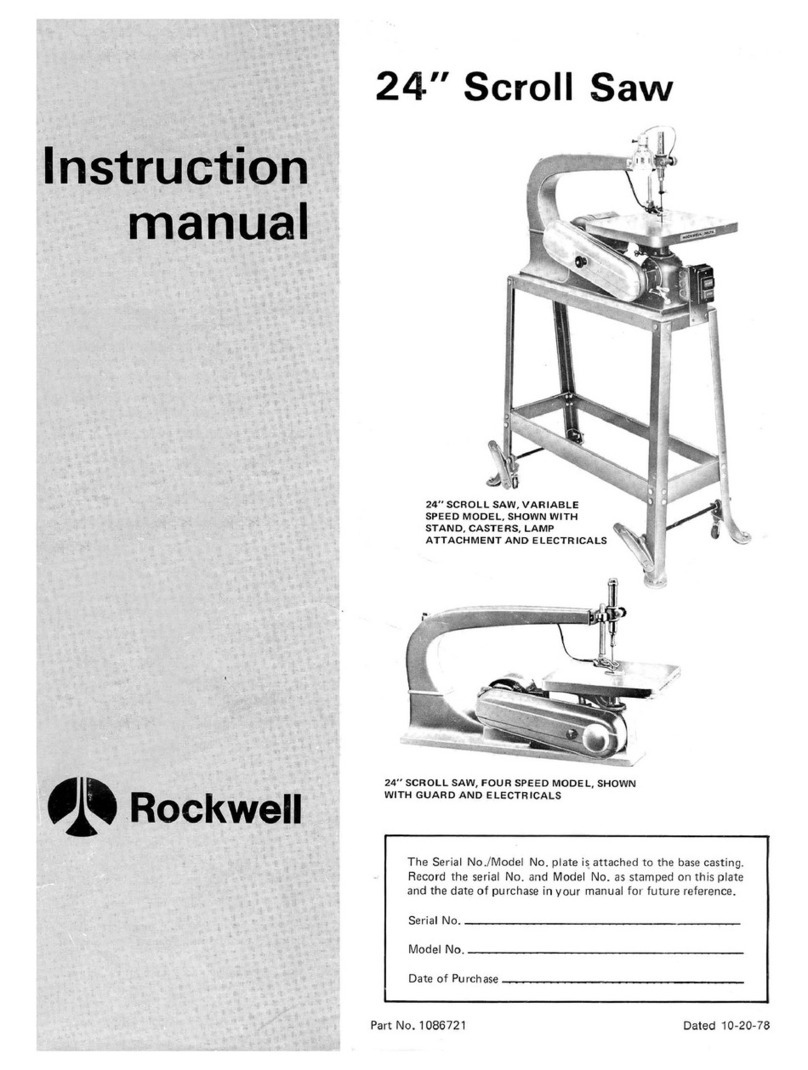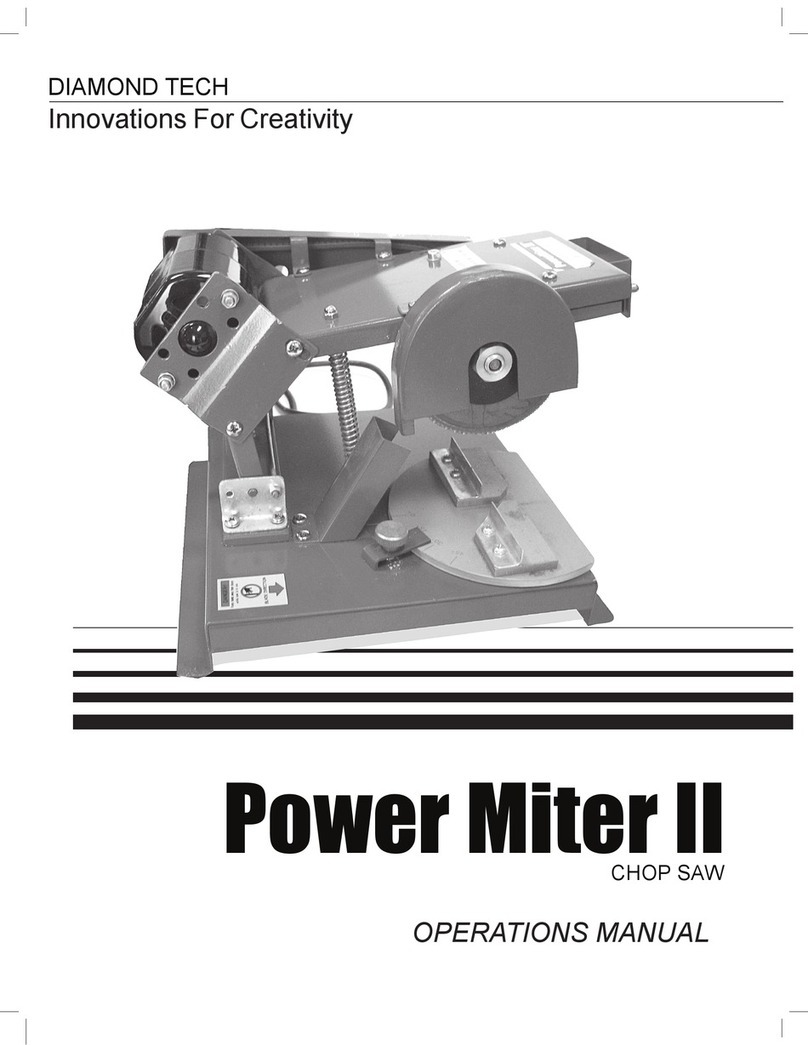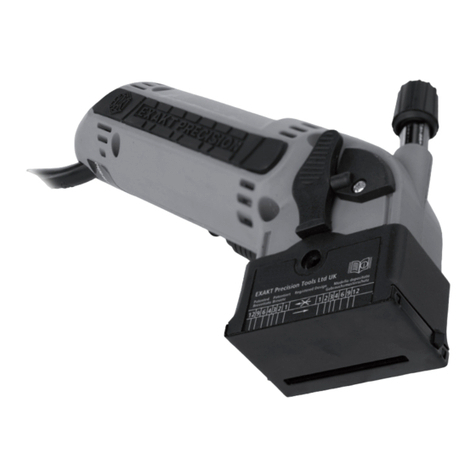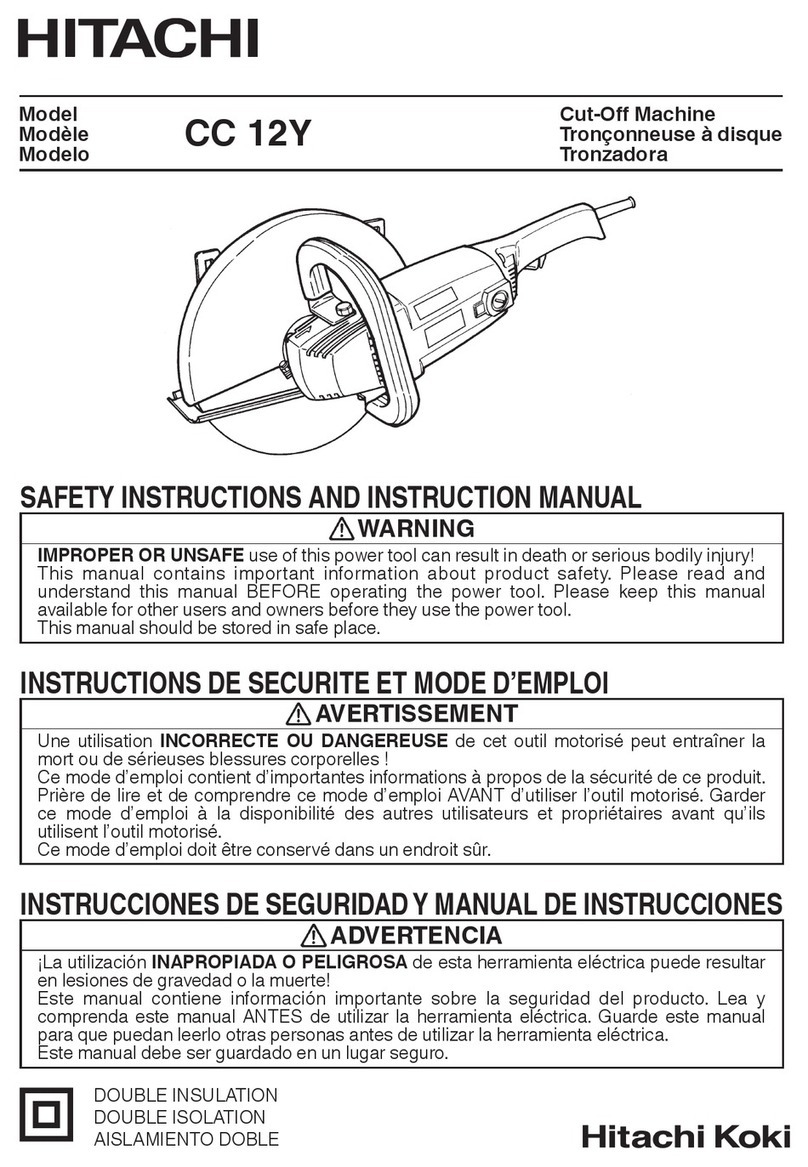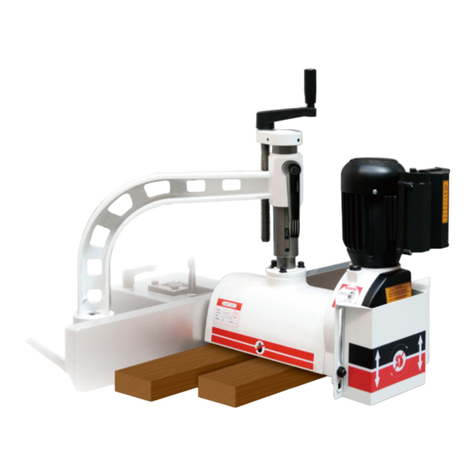FERREX 704518 User manual

User Manual
704518
1200W CIRCULAR SAW
Read all safety warnings and all instructions
thoroughly before operating this product.
Ensure you keep your manual in a
safe place for future reference.
IM ed 1; 02/2022
Product
Info

QR codes take you where you want to go
quicky and easily
Whether you require product information, spare parts or accessories,
details on warranties or after sales service, or if you want to watch
a product demonstration video, our QR codes will take you there in
no time at all.
What is a QR code?
A QR-code (QR=Quick Response) is a type of matrix that can be read
with a smartphone camera and that contains a link to a website or
contact details, for example.
Advantage: You are not required to manually enter a website address
or contact details.
How it works
To scan the QR code, all you need is a smartphone with QR codes reader
software and an Internet connection*. This type of software can be
downloaded for free from your smartphone’s app store.
Try it out now
Just scan the QR code with your smartphone and
nd out more about the Aldi product you have
purchased*.
* Depending on your tarif you may be charged
for the connection.
Product
Info

REGISTER YOUR PURCHASE AT www.aldi.com.au/en/about-aldi/product-registration/TO KEEP UP-TO-DATE WITH IMPORTANT PRODUCT INFORMATION.
The product is guaranteed to be free from defects in workmanship and parts for a period of 36 months from the
date of purchase. Defects that occur within this warranty period, under normal use and care, will be repaired,
replaced or refunded at our discretion. The benets conferred by this warranty are in addition to all rights and
remedies in respect of the product that the consumer has under the Competition and Consumer Act 2010 and
similar state and territory laws.
Our goods come with guarantees that cannot be excluded under the Australian Consumer Law. You are entitled
to a replacement or refund for a major failure and for compensation for any other reasonably foreseeable loss or
damage. You are also entitled to have the goods repaired or replaced if the goods fail to be of acceptable quality
and the failure does not amount to a major failure.
Warranty details
AFTER SALES SUPPORT
(toll free)
3
1200W Circular Saw
MODEL No.: PSC1856.A •02/2022 • 704518

Contents
Pack contents / parts 2
Description of symbols 3
General safety warnings 4
Parts list 10
Assembly 12
Attaching the dust extraction adapter 12
Attaching the parallel guide 12
Operation 13
Adjusting the bevel angle 13
Adjusting the cutting depth 13
Adjusting the parallel guide 14
Hand grip position 14
Safety lock o button 14
Working hints for your circular saw 15
Making a cut 15
Making a pocket cut 16
Maintenance 17
Environmental protection 19
Warranty 20
What your 3 year warranty means 21
Service support 21
Accessories and after sales parts 22
Troubleshooting 23
Technical specications 24

Pack contents / parts
Congratulations on the purchase of your FERREX® 1200W Circular Saw. When
you open your packaging, rst remove all items and check there are no parts
damaged or missing. If you nd anything wrong, do not operate the product
until the parts have been replaced or the fault has been rectied. Failure to
do so could result in serious personal injury.
First time users or inexperienced operators pay particular attention to
the operation of the 1200W Circular Saw, including details of starting and
stopping and correct use of the 1200W Circular Saw on pages 13-17, as well
as the maintenance instructions on pages 17-19.
Intended use of 1200W Circular Saw
NOTE: This product is for private domestic DIY use only. It is not suitable for
commercial or trade use.
This 1200W Circular Saw is used for lengthways and crossways cutting of
wood with straight cutting lines as well as bevel angles to 45° while resting
rmly on the work piece.
The 1200W Circular Saw is to be used only for its prescribed purpose. Any
other use is deemed to be a case of misuse.
Contents of carton
1 x 1200W Circular Saw
2 x 185*20mm*24T Blade
1 x Parallel Guide
1 x Wrench
1 x Dust Extraction Adapter
1 x 6mm Hex Key
1 x Instruction Manual
1 x Warranty Card & Certicate
2
WARNING! Please read and understand this instruction manual
before use and keep it for your future reference. Your product
should only be passed on together with this instruction manual.

Description of symbols
The instruction manual, rating plate, or on the product itself, may show
these symbols. These represent important information about the product or
instructions on its use.
Read instruction manual before operating this machine
Warning
Wear hearing protection.
Wear eye protection.
Wear breathing protection.
Double insulation
Wear protective gloves
Conforms to relevant standards for electrical safety and electromagnetic
compatibility
36 Months Warranty
The box is recyclable at the kerbside.
The inserts are recyclable at the kerbside.
36
Box
3

General safety warnings
4
WARNING: WARNING: Read all safety warnings, instructions,
illustrations and specications provided with this power tool.
Failure
to follow the warnings and instructions may result in electric shock, re and/or
serious injury.
Save all warnings and instructions for future reference.
The term “power tool” in the warnings refers to your mains-operated (corded)
power tool or battery-operated (cordless) power tool.
1) Work area safety
a) Keep work area clean and well lit.
Cluttered or dark areas invite accidents.
b) Do not operate power tools in explosive atmospheres, such as in the
presence of ammable liquids, gases or dust.
Power tools create sparks
which may ignite the dust or fumes.
c) Keep children and bystanders away while operating a power tool.
Distractions can cause you to lose control.
2) Electrical safety
a) Power tool plugs must match the outlet. Never modify the plug in any
way. Do not use any adapter plugs with earthed (grounded) power
tools.
Unmodied plugs and matching outlets will reduce risk of electric
shock.
b) Avoid body contact with earthed or grounded surfaces, such as pipes,
radiators, ranges and refrigerators.
There is an increased risk of electric
shock if your body is earthed or grounded.
c) Do not expose power tools to rain or wet conditions.
Water entering a
power tool will increase the risk of electric shock.
d)
Do not abuse the cord. Never use the cord for carrying, pulling or
unplugging the power tool. Keep cord away from heat, oil, sharp edges or
moving parts.
Damaged or entangled cords increase the risk of electric shock.
e) When operating a power tool outdoors, use an extension cord suitable
for outdoor use.
Use of a cord suitable for outdoor use reduces the risk of
electric shock.

f) If operating a power tool in a damp location is unavoidable, use a
residual current device (RCD) protected supply.
Use of an RCD reduces
the risk of electric shock.
3) Personal safety
a) Stay alert, watch what you are doing and use common sense when
operating a power tool. Do not use a power tool while you are tired
or under the inuence of drugs, alcohol or medication.
A moment of
inattention while operating power tools may result in serious personal
injury.
b) Use personal protective equipment. Always wear eye protection.
Protective equipment such as dust mask, non-skid safety shoes, hard hat,
or hearing protection used for appropriate conditions will reduce personal
injuries.
c) Prevent unintentional starting. Ensure the switch is in the o-position
before connecting to power source and/or battery pack, picking up or
carrying the tool.
Carrying power tools with your nger on the switch or
energising power tools that have the switch on invites accidents.
d) Remove any adjusting key or wrench before turning the power tool
on.
A wrench or a key left attached to a rotating part of the power tool may
result in personal injury.
e) Do not overreach. Keep proper footing and balance at all times.
This
enables better control of the power tool in unexpected situations.
f) Dress properly. Do not wear loose clothing or jewellery. Keep your hair,
clothing and gloves away from moving parts.
Loose clothes, jewellery or
long hair can be caught in moving parts.
g) If devices are provided for the connection of dust extraction and
collection facilities, ensure these are connected and properly used.
Use
of these devices can reduce dust-related hazards.
h) Do not let familiarity gained from frequent use of tools allow you to
become complacent and ignore tool safety principles.
A careless action
can cause severe injury within a fraction of a second.
4) Power tool use and care
a) Do not force the power tool. Use the correct power tool for your
application.
The correct power tool will do the job better and safer at the
rate for which it was designed.
b) Do not use the power tool if the switch does not turn it on and o.
Any
5

6
power tool that cannot be controlled with the switch is dangerous and must
be repaired.
c) Disconnect the plug from the power source and/or the battery pack
from the power tool before making any adjustments, changing
accessories, or storing power tools.
Such preventive safety measures
reduce the risk of starting the power tool accidentally.
d) Store idle power tools out of the reach of children and do not allow
persons unfamiliar with the power tool or these instructions to operate
the power tool.
Power tools are dangerous in the hands of untrained users.
e) Maintain power tools. Check for misalignment or binding of moving
parts, breakage of parts and any other condition that may aect the
power tool’s operation. If damaged, have the power tool repaired
before use.
Many accidents are caused by poorly maintained power tools.
f) Keep cutting tools sharp and clean.
Properly maintained cutting tools
with sharp cutting edges are less likely to bind and are easier to control.
g) Use the power tool, accessories and tool bits etc. in accordance with
these instructions, taking into account the working conditions and the
work to be performed.
Use of the power tool for operations dierent from
those intended could result in a hazardous situation.
h) Keep handles and grasping surfaces dry, clean and free from oil and
grease.
Slippery handles and grasping surfaces do not allow for safe
handling and control of the tool in unexpected situations.
5) Service
a) Have your power tool serviced by a qualied repair person using only
identical replacement parts.
This will ensure that the safety of the power
tool is maintained.
6) Recommendation
Recommendation that the tool always be used via a residual current de-
vice having a rated residual current of 30 mA or less.
Safety instructions for all saws
Cutting procedures
a) DANGER: Keep hands away from cutting area and the blade. Keep
your second hand on auxiliary handle, or motor housing.
If both hands
are holding the saw, they cannot be cut by the blade.

b) Do not reach underneath the workpiece.
The guard cannot protect you
from the blade below the workpiece.
c) Adjust the cutting depth to the thickness of the workpiece.
Less than a
full tooth of the blade teeth should be visible below the workpiece.
d) Never hold the workpiece in your hands or across your leg while
cutting. Secure the workpiece to a stable platform.
It is important to
support the work properly to minimise body exposure, blade binding, or
loss of control.
e) Hold the power tool by insulated gripping surfaces, when performing
an operation where the cutting tool may contact hidden wiring or its
own cord.
Contact with a "live" wire will also make exposed metal parts of
the power tool "live" and could give the operator an electric shock.
f) When ripping, always use a rip fence or straight edge guide.
This
improves the accuracy of cut and reduces the chance of blade binding.
g) Always use blades with correct size and shape (diamond versus round)
of arbour holes.
Blades that do not match the mounting hardware of the
saw will run o-centre, causing loss of control.
h) Never use damaged or incorrect blade washers or bolt.
The blade
washers and bolt were specially designed for your saw, for optimum
performance and safety of operation.
Further safety instructions for all saws
Kickback causes and related warnings
Kickback is a sudden reaction to a pinched, jammed or a misaligned saw
blade, causing an uncontrolled saw to lift up and out of the workpiece
toward the operator.
When the blade is pinched or jammed tightly by the kerf closing down,
the blade stalls and the motor reaction drives the unit rapidly back toward
the operator.
If the blade becomes twisted or misaligned in the cut, the teeth at the
back edge of the blade can dig into the top surface of the wood causing
the blade to climb out of the kerf and jump back toward the operator.
Kickback is the result of saw misuse and/or incorrect operating procedures
or conditions and can be avoided by taking proper precautions as follows.
a) Maintain a rm grip with both hands on the saw and position your arms
to resist kickback forces. Position your body to either side of the blade,
7

but not in line with the blade.
Kickback could cause the saw to jump
backwards, but kickback forces can be controlled by the operator, if proper
precautions are taken.
b) When blade is binding, or when interrupting a cut for any reason,
release the trigger and hold the saw motionless in the material until
the blade comes to a complete stop. Never attempt to remove the saw
from the work or pull the saw backward while the blade is in motion or
kickback may occur.
Investigate and take corrective actions to eliminate
the cause of blade binding.
c) When restarting a saw in the workpiece, centre the saw blade in the
kerf so that the saw teeth are not engaged into the material.
If a saw
blade binds, it may walk up or kickback from the workpiece as the saw is
restarted.
d) Support large panels to minimise the risk of blade pinching and
kickback.
Large panels tend to sag under their own weight. Supports must
be placed under the panel on both sides, near the line of cut and near the
edge of the panel.
e) Do not use dull or damaged blades.
Unsharpened or improperly set
blades produce narrow kerf causing excessive friction, blade binding and
kickback.
f) Blade depth and bevel adjusting locking levers must be tight and
secure before making the cut.
If blade adjustment shifts while cutting, it
may cause binding and kickback.
g) Use extra caution when sawing into existing walls or other blind areas.
The protruding blade may cut objects that can cause kickback.
Safety instructions for saws (Circular saw with inner pendulum guard)
Lower guard function
a) Check the lower guard for proper closing before each use. Do not
operate the saw if the lower guard does not move freely and close
instantly. Never clamp or tie the lower guard into the open position.
If the saw is accidentally dropped, the lower guard may be bent. Raise the
lower guard with the retracting handle and make sure it moves freely and
does not touch the blade or any other part, in all angles and depths of cut.
b) Check the operation of the lower guard spring. If the guard and the
spring are not operating properly, they must be serviced before use.
Lower guard may operate sluggishly due to damaged parts, gummy
8

12
MODEL No.: PSC1856.A • 02/2022 • 704518
AFTER SALES SUPPORT
(toll free)
1200W Circular Saw
9
deposits, or a build-up of debris.
c) The lower guard may be retracted manually only for special cuts such as
"plunge cuts" and "compound cuts." Raise the lower guard by retracting
handle and as soon as the blade enters the material, the lower guard
must be released.
For all other sawing, the lower guard should operate
automatically.
d) Always observe that the lower guard is covering the blade before
placing the saw down on bench or oor.
An unprotected, coasting blade
will cause the saw to walk backwards, cutting whatever is in its path. Be
aware of the time it takes for the blade to stop after switch is released.
ADDITIONAL SAFETY RULES FOR YOUR CIRCULAR SAW
1. Only use saw blades recommended in the specication.
2. Do not use any abrasive wheels.
3. Use only blade diameter(s) in accordance with the markings.
4. Identify the correct saw blade to be used for the material to be cut.
5. Use only saw blades that are marked with a speed equal or higher than the
speed marked on the tool.

12
MODEL No.: PSC1856.A • 02/2022 • 704518
AFTER SALES SUPPORT
(toll free)
1200W Circular Saw
10
MODEL No.: PSC1856.A • 02/2022 • 704518
AFTER SALES SUPPORT
(toll free)
1200W Circular Saw
Parts list
1. Soft grip handle
2. Front handle
3. Base plate angle scale
4. Parallel guide lock knob
5. Parallel guide
6. Base plate bevel lock knob
7. Base plate
8. Lower guard
9. Lower guard lever
10. Upper xed guard
11. Dust extraction outlet
12. On/o trigger
13. Lock-o button
14. Cutting depth scale
15. Cutting depth lock knob
16. Cutting mark, 0°
17. Cutting mark, 45°
18. Saw blade
19. Outer ange
20. Washer
21. Blade bolt
22. Wrench
23. Dust extraction adapter
24. 6mm Hex key

11
MODEL No.: PSC1856.A • 02/2022 • 704518
AFTER SALES SUPPORT
(toll free)
1200W Circular Saw
4
2
3
22 23 24
13
12
14
15
16 17
18
19
20
21
6
7
5
8
9
10
11
1

12
MODEL No.: PSC1856.A • 02/2022 • 704518
AFTER SALES SUPPORT
(toll free)
1200W Circular Saw
Assembly
WARNING: Ensure the product is disconnected from the mains
power supply before attempting any assembly.
Attaching the dust extraction adapter
Fasten the dust extraction adapter (23) onto the dust
extraction outlet (11) until it latches. Directly connect
a suitable vacuum hose to the adapter.
(Fig. A)
NOTE: The dust extraction adapter (23) must not
be mounted when no external dust extraction
is connected. Otherwise there is danger of the
extraction system becoming clogged.
Clean the dust extraction adapter (23) regularly
to ensure optimum dust extraction. The vacuum
cleaner must be suitable for the material to be worked.
Attaching the parallel guide
The parallel guide is used for making cuts parallel to a workpiece edge at a
chosen distance. First turn the parallel guide lock knob (4) anti-clockwise to
loosen (Fig. B1), then slide the parallel guide (5) arm through the xture to
achieve the required cutting distance (Fig. B2), then tighten the parallel guide
lock knob (4) by turning it clockwise to securely clamp the parallel guide (5) (Fig.
B3).
NOTE:
It is best to carry out a trial cut before cutting your workpiece.
B1
B2
B3
A

13
MODEL No.: PSC1856.A • 02/2022 • 704518
AFTER SALES SUPPORT
(toll free)
1200W Circular Saw
Operation
Adjusting the bevel angle
Turn the base plate bevel lock knob (6) anti-clockwise to loosen (Fig. C1), and
tilt the machine away from the base plate (7) (Fig. C2). Set the required bevel
angle by aligning the triangle symbol with the base plate angle scale (3) (Fig.
C3).
Tighten the base plate bevel lock knob (6) by turning it in clockwise
direction.
WARNING! Do not use the depth of cut scale when making bevel
cuts due to possible inaccuracy.
C1 C2 C3
Adjusting the cutting depth
Turn the cutting depth lock knob (15) anti-clockwise to loosen (Fig. D1), and
raise the saw body away from the base plate (7). Set the required cutting
depth by aligning the line symbol (at the rear of the upper xed guard) with
the cutting depth scale (14) (Take the line mark below the number as the
standard) (Fig. D2). Turn the cutting depth lock knob (15) clockwise to lock
the cutting depth (Fig. D3).
When set correctly, the blade teeth should not protrude further than 3mm
beneath the workpiece.
NOTE:
It is best to carry out a trial cut before cutting your workpiece.

14
MODEL No.: PSC1856.A • 02/2022 • 704518
AFTER SALES SUPPORT
(toll free)
1200W Circular Saw
D1
D2
D3
Adjusting the parallel guide
There is a cutting guide notch on the front of the base
plate (7) for use with the parallel guide (5)
(Fig. E)
.
For straight cuts, use the 0º guide mark (16) to align
with your parallel guide scale.
For a 45º bevel cut, use the 45º guide mark (17) to
align with your parallel guide scale.
Securely clamp the parallel guide (5). Always make a
trial cut to check the setting.
Hand grip position
Always hold your saw rmly with both hands
when operating, with one hand controlling the
on/o trigger and the other hand on the front
handle for support and pressure. (Fig. F).
Safety Lock O button
This circular saw has a lock o button to prevent
accidental starting. Depress lock o button (13)
then the on/o trigger (12) and then release the
lock o button (13). Your switch is now on. To
switch o just release the on/o trigger (12) (Fig. G).
The blade may continue to rotate after switching
o. Wait until the machine comes to a complete
stop before setting down.
F
G
1
2
E45o0o

15
MODEL No.: PSC1856.A • 02/2022 • 704518
AFTER SALES SUPPORT
(toll free)
1200W Circular Saw
Working hints for your circular saw
If your saw becomes too hot, run your circular saw no load for 2-3 minutes
to cool the motor. Avoid prolonged usage at very low speeds.
Always use a blade suited to the material and material thickness to be cut.
The quality of cut will improve as the number of blade teeth increases.
Always ensure the work-piece is rmly held or clamped to prevent
movement. Support large panels close to the cut line.
Any movement of the material may aect the quality of the cut. The blade
cuts on the upward stroke and may chip the uppermost surface or edges of
your work piece. When cutting, ensure your uppermost surface is a non-
visible surface when your work is nished. Feeding too fast signicantly
reduces the performance of the machine and shortens the life of the
saw blade. Always face the good side of the work-piece down, to ensure
minimum splintering. Only use sharp saw blades of the correct type.
Making a cut
1. Mark the line of cut on your work piece.
2. Adjust the depth of cut and bevel angle as required per previous
instructions.
3. When making 90° cross or rip cuts, align your line of cut with the outer
blade guide notch on the base plate (7) of the saw (Fig. H).
4. When making 45° bevel cuts, align your line of cut with the inner blade
guide notch on the base plate (7) of the saw (Fig. H).
5. Rest the front edge of the base on the work piece (Fig. I).
6. Start the motor by depressing the lock o button (13) and squeezing the
on/o trigger (12).
NOTE: Always let the blade reach full speed (approximately 2 seconds)
before you begin to cut into the work piece.
7. Slowly push the circular saw forward using both hands (Fig. J).
8. When making a cut always use steady, even pressure. Forcing the circular
saw causes rough cuts and could shorten the life of the circular saw or cause
kickback. Allow the blade and the circular saw to do the work.
9. After completing your cut, release the on/o trigger (12) and allow the
blade to come to a complete stop.

16
MODEL No.: PSC1856.A • 02/2022 • 704518
AFTER SALES SUPPORT
(toll free)
1200W Circular Saw
NOTE: Do not remove the saw from the work piece while the blade is
moving.
NOTE: Since blade thickness varies, always make a trial cut in scrap material
along the guideline to determine how much, if any, the guideline must be
oset to get an accurate cut.
H45o0o
I
J
Making a pocket cut
1. Adjust the depth of cut as required per previous instructions
2. Adjust the bevel setting to 0°.
3. Raise the lower blade guard lever (9) to expose the saw blade and rmly
rest the front of the base at against the work piece with the rear handle
raised so the blade does not touch the work piece (Fig. K).
4. With the blade just clearing the work piece, start the motor by depressing
lock o button (13) and squeezing the on/o trigger (12).
5. Always let the blade reach full speed (approximately 2 seconds) before
you begin to cut into the work piece.
6. Slowly lower the circular saw into the work piece, using the front of the
base resting on the work piece as a hinge point.
WARNING! As soon as the blade starts cutting the material,
release the lower blade guard lever (9).
7. Once the base plate is at against the work piece, proceed cutting in a
forward direction to the end of the cut.
8. After completing your cut, release the on/o trigger (12) and allow the
blade to come to a complete stop.
Do not remove the circular saw from the work piece while the blade is
moving.

17
MODEL No.: PSC1856.A • 02/2022 • 704518
AFTER SALES SUPPORT
(toll free)
1200W Circular Saw
Maintenance
Changing a saw blade
WARNING! Before performing any maintenance or adjustment,
remove the plug from the socket.
WARNING! Wear protective gloves when mounting the saw
blade. Danger of injury when touching the saw blade.
WARNING! Only use saw blades compatible with this machine,
check details in these instructions.
WARNING! Do not use grinding discs as the cutting tool under
any circumstances.
-Removing
1) Use the supplied wrench (22) to x the spindle (Fig. L1).
2) Loosen the blade bolt (21) in an anti-clockwise direction with the 6mm
hex key (24) (Fig. L1). Remove the the blade bolt (21), the washer (20) and
the outer ange (19) (Fig. L2).
3) Tilt back the lower blade guard (8) and hold it rmly with the lower guard
lever (9). Remove the old saw blade (Fig. L3).
NOTE: If the corners of your pocket cut are not completely cut through, use a
jigsaw or hand saw to nish the corners.
K
Table of contents
Other FERREX Saw manuals

